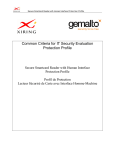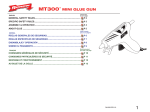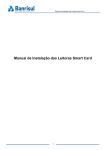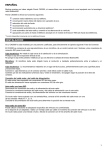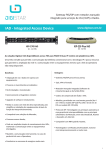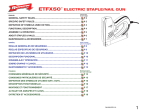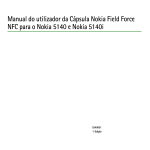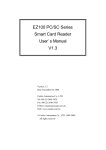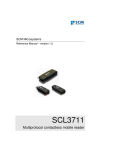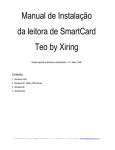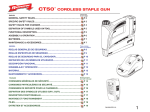Download Smartcard reader Leo V2 Security Target Lite
Transcript
Smartcard reader Leo V2 Security Target Lite Common Criteria EAL3+ Document reference: XRD-2012-1626 Version: 1.0 © XIRING. Communication, reproduction et utilisation interdites - Copyright and all other rights reserved Security target lite/ Leo V2 / EAL3+ XRD-2012-1626 Table of content 1 ST INTRODUCTION........................................................................................................... 3 1.1 1.2 1.3 1.4 1.5 ST REFERENCE ........................................................................................................................... 3 TOE REFERENCE ........................................................................................................................ 3 TOE INTRODUCTION ................................................................................................................... 3 TOE OVERVIEW .......................................................................................................................... 4 TOE DESCRIPTION ...................................................................................................................... 4 2 LIFECYCLE ........................................................................................................................ 5 3 CONFORMANCE CLAIMS ................................................................................................ 6 4 SECURITY PROBLEM DEFINITION ................................................................................. 7 4.1 SUBJECTS.................................................................................................................................... 7 4.2 ASSETS........................................................................................................................................ 7 4.2.1 Sensitive assets protected by the TOE..................................................................................... 7 4.2.2 Sensitive assets of the TOE ..................................................................................................... 8 4.3 THREATS ..................................................................................................................................... 8 4.3.1 Threat agents........................................................................................................................... 8 4.3.2 Attack potential ....................................................................................................................... 8 4.3.3 The threats to the TOE by an attacker are: ............................................................................ 9 4.4 ORGANISATIONAL SECURITY POLICIES ....................................................................................... 9 4.5 ASSUMPTIONS ............................................................................................................................. 9 5 SECURITY OBJECTIVES ................................................................................................ 10 5.1 5.2 5.3 SECURITY OBJECTIVES FOR THE TOE...................................................................................... 10 SECURITY OBJECTIVES FOR THE ENVIRONMENT ...................................................................... 10 SECURITY OBJECTIVES RATIONALE ........................................................................................... 10 6 EXTENDED COMPONENTS DEFINITION ...................................................................... 11 7 SECURITY REQUIREMENTS .......................................................................................... 12 7.1 7.2 7.3 7.4 SECURITY FUNCTIONAL REQUIREMENTS................................................................................... 12 FUNCTIONAL REQUIREMENT DEPENDENCIES ............................................................................ 16 SECURITY ASSURANCE REQUIREMENTS ................................................................................... 16 SECURITY REQUIREMENTS RATIONALE ..................................................................................... 17 8 ACRONYMS ..................................................................................................................... 18 9 BIBLIOGRAPHY .............................................................................................................. 18 © XIRING. Communication, reproduction et utilisation interdites - Copyright and all other rights reserved 2/18 Security target lite/ Leo V2 / EAL3+ XRD-2012-1626 1 ST introduction This security target describes the functional and organisational security requirements and procedures for the TOE, a “secure pin entry device” (also known as “the Device”), and its operational environment. The target of evaluation is the Leo V2 smart card reader. 1.1 ST reference Title of the Security Target Smartcard reader Leo V2 Security Target Common Criteria EAL3+ Version 1.0 Issue date 11/07/2012 Document ID XRD-2012-1626 Author Damien COCHET, Claude MEGGLÉ Evaluation level EAL3 + Protection Profile Secure Smartcard Reader with Human Interface Protection Profile v1.6 1.2 TOE reference Target of evaluation Leo V2 (id 633) Version PPD001-003-AXY* where X and Y are minor revisions numbers not related to the security features of the TOE. Issue date Firmware version PK08.12 Issue date *where X and Y are minor revisions numbers that are not related to the security features of the TOE. 1.3 TOE introduction A smartcard is a piece of plastic, with an electronic component embedded in it. It has no human interface but only a physical connector (ISO 7816 type ) to link to a smartcard reader, and the smartcard reader has normally a serial type connector, to link to a Personal Computer (PC), or Workstation. The PC may be a Microsoft Windows, Mac or Linux OS powered. The security of the PC is out of scope of the TOE. As a Personal Identification Number (also known and referred as ‘PIN’) is required for some smartcard applications, this PIN is usually keyed on the PC keyboard and forwarded to the smartcard through PC/SC [3] and ISO 7816 / EMV commands [4, 10]. As the security of the PC cannot be guaranteed, a malware (virus, Trojan, worm, key logger…) could intercept the PIN, record it to replay it or forward it to a remote attacker. Such a malware can also use the security mechanisms of the smartcard to block the smartcard application (denial of service attack type), by providing the smartcard with a modified (and false) personal data (example: PIN). © XIRING. Communication, reproduction et utilisation interdites - Copyright and all other rights reserved 3/18 Security target lite/ Leo V2 / EAL3+ XRD-2012-1626 As the smartcard may be used to sign some critical information, the display a Device may be used to provide the user with a mean to check this information, even partially, or to approve explicitly the operation before signing it. The purpose of the Device is to avoid compromising the PIN or modifying the critical information to be signed by such a malware: the PIN is never keyed on the PC keyboard, but on the Device keypad, and forwarded directly to the smartcard and never transmitted to the PC. There is no way for a malware to ask for a PIN to the Device and to receive this PIN. There is also no way for a malware to ask for a PIN on the PC keyboard and forward it to the smartcard. The Device is supposed to be used in a private environment. That is to say that the Device is to be used by an individual, or a small group of persons (limited to a well defined group persons), in a place under control of this individual, or group of persons, so it can be used at home, or at the office. The Device is not intended to be used in a public area. The Device embeds a « smartcard reader ». 1.4 TOE overview The Leo V2 smart card reader is a secure PIN entry device, a universal smart card reader with keypad, display and a connecting cable with USB connector. The Leo V2 smart card reader cannot be used in standalone mode. It must be plugged in a Personal Computer USB plug to offer capability for secure PIN entry. The Personal Computer can be a PC with a Windows OS, Linux or Mac OS. The secure PIN entry functionality can be activated from a software application loaded in the PC (not provided and out of scope of this TOE), and used in conjunction with a secure smartcard (not provided and out of scope of this TOE). 1.5 TOE description The Leo V2 smart card reader is a universal smart card reader devices, which can communicate with ISO 7816 and EMV2004 compliant processor cards through the PC/SC [3] application interface. The devices work with any smart card transmission protocol compliant with ISO 7816 [4] (T=0, T=1). Leo V2 reader has a keypad with silicone keys, to enter a digital PIN. The numeric keys “0” to “9” as well as the keys “Clear” (yellow), “OK” (green) and “Cancel” (red) are present. The reader complies with PC/SC part 10 [3] and CCID secure command specifications [8]. Therefore, within the frame of a Secure Pin Entry session, the device inserts the digits keyed on the keypad as a PIN in the PIN field of the command to the smart card. The PIN is formatted according to external parameters transmitted through the accurate CCID PC_RDR_Secure commands as described in [8]. The firmware in the TOE manages the security functions. The reader can be connected to all USB equipped host systems, like PC computers, running Microsoft Windows, Linux or Mac OS. It is used as peripherals in the PC surrounding field. The reader is provided with power supply through the USB interface. It cannot be used in standalone mode. © XIRING. Communication, reproduction et utilisation interdites - Copyright and all other rights reserved 4/18 Security target lite/ Leo V2 / EAL3+ XRD-2012-1626 PC applications communicate with the reader through PC/SC [3] interfaces. The reader is declared and recognized as a PC/SC [3] device by its PC host driver. All functions at the interfaces are illustrated for PC/SC in accordance with [3]. Microcontroller RAM Flash (FW) Smart card interface USB interface DISPLAY KEYPAD Details on available host software such as drivers are available in the user manual of the Leo V2. The driver software is not included in this evaluation. The TOE ends at the USB interface to the host computer. Installation software including drivers, manual and tools can be downloaded from: http://www.xiring.com/XIRING-support_leo_by_XIRING.asp The Leo V2 reader is able to enter identification data (PIN) and convey it securely to a smart card, for instance a secure signature creation device. It can be used also to allow authorise access to some applications or to the computer itself, if the appropriate software has been installed, and the firmware of the TOE adapted. The firmware is filtering the commands sent to the reader for secure PIN input, and allows only PC/SC commands which involved data identification (PIN). Therefore there is no way to address directly the pinpad or the display. The housing is sealed by means of falsification secure security stickers, which will be destroyed when someone attempt to open it. Stickers can be used only once. 2 Lifecycle The firmware is part of the TOE. It is integrated in the TOE at the end of the fabrication process by flashing an EEPROM memory (and destroying a fuse thus disabling the possibility © XIRING. Communication, reproduction et utilisation interdites - Copyright and all other rights reserved 5/18 Security target lite/ Leo V2 / EAL3+ XRD-2012-1626 of flashing another firmware). Security stickers are put in place at the end of the fabrication process. The fabrication process is outsourced to a partner factory/manufacturer. Security policies, defined by XIRING, enforcing confidence in firmware integrity management from delivery through flashing operation on the production chain have been transmitted to the manufacturer. A specific policy for security sticker management at the factory site was also defined for the manufacturer. Hardware development Hardware development Hardware assembly / fabrication Firmware insertion / flashing Delivery Use phase Figure 1: Lifecycle of the TOE. Grey blocks are in the scope of the TOE. The delivery point is located at the XIRING partner factory where goods are passed to a forwarder for delivery. 3 Conformance Claims The security target with its functional requirements claims a demonstrable conformance to the “Secure Smartcard Reader with Human Interface” Protection Profile [12]. Therefore, this security target is conformant to the Common Criteria, Version 3.1, Release 3, dated July 2009 as follow: - Part 2 of the Common Criteria, Version 3.1, Release 3, dated July 2009, - Part 3 of the Common Criteria, Version 3.1, Release 3, dated July 2009 The claimed assurance level is EAL3 augmented with AVA.VAN.3, ADV_FSP.4, ADV_TDS.3, ADV_IMP.1, ALC_TAT.1 and ALC_FLR.3. © XIRING. Communication, reproduction et utilisation interdites - Copyright and all other rights reserved 6/18 Security target lite/ Leo V2 / EAL3+ XRD-2012-1626 4 Security problem definition PPrivate environment Untrusted PC TOE Secure Smartcard Secure physical path Figure 2: The TOE and its environment. 4.1 Subjects S.PC: A personal computer that can communicate with the pinpad via a USB connection. S.INTERFACE: represents a logical or physical communication interface that can be used by any type of users. S.USER: A user of the TOE. S.ICC: A smartcard that can be used with the TOE. 4.2 Assets 4.2.1 Sensitive assets protected by the TOE The assets that have to be protected are identification data (B.PIN) of the user and critical information to be displayed before signing (B.DIS). B.PIN The identification data (B.PIN) is an external asset which passes through the Device. The Device has been designed to protect this external asset, in confidentiality (this data must be passed uniquely to the smartcard), and in integrity (a modified identification data can block the smartcard application). Sensitivity: confidentiality, integrity B.DIS © XIRING. Communication, reproduction et utilisation interdites - Copyright and all other rights reserved 7/18 Security target lite/ Leo V2 / EAL3+ XRD-2012-1626 The critical information to be approved (B.DIS) is an internal (message in the firmware for example) or external asset. The Device has been designed to protect this asset against modification inside the TOE. Examples of external assets: An external asset may be a piece of data received from the PC in a command, displayed on the display of the device and checked by the user before validating the command. An external asset may be also a piece of data received from the smartcard, displayed on the display of the device and checked by the user before validating the command. Sensitivity: integrity 4.2.2 Sensitive assets of the TOE The assets of the TOE which can be attacked are: B.FIRM The Firmware of the TOE B.HARD The Hardware of the TOE B.FIRM The firmware .This sensitive asset corresponds to all TOE programs. These programs are held in memory of the TOE. Sensitivity: integrity. B.HARD The hardware. This sensitive asset corresponds to the hardware casing of the TOE, in the use stage, just after firmware download. Sensitivity: integrity. 4.3 Threats 4.3.1 Threat agents During the use stage, a threat agent can be: U_agressor: an aggressor: this is a person who has not received a product in an authorised way or otherwise gains illicit access to the TOE. The aggressor may gain access to the TOE through the PC, or have temporary access to the TOE when not in use, and modify it. As the TOE is to be used in a private environment, the legitimate user is not considered hostile. 4.3.2 Attack potential Individuals performing attacks have an Enhanced Basic attack potential. They correspond to malicious persons possessing the computing skills of a well-informed user having gained access to some restricted information about the TOE. © XIRING. Communication, reproduction et utilisation interdites - Copyright and all other rights reserved 8/18 Security target lite/ Leo V2 / EAL3+ XRD-2012-1626 4.3.3 The threats to the TOE by an attacker are: The assets that have to be protected are identification data (B.PIN) of the user, and critical information to be displayed before signing (B.DIS) as well as the firmware (B.FIRM) and hardware (B.HARD) of the smart card reader itself. The reader itself has no secret. T.PIN_DISCLOSE: An attacker can try to access the pin B.PIN, and transmit it out of the TOE, by gaining access to the firmware B.FIRM or the hardware B.HARD of the TOE. T.PIN_MODIFY: An attacker can try to modify the pin B.PIN in the TOE and block the smartcard application (false Pin counter), by modifying the firmware B.FIRM or inserting a hardware bug in the hardware B.HARD. T.DIS: An attacker modifies the information to be displayed and/or signed by the Device (B.DIS), before sending it to the Device. Or an attacker can try to modify the critical information to be approved (B.DIS), by modifying the firmware B.FIRM or inserting a bug in the hardware B.HARD. 4.4 Organisational security policies OSP.USER: A written procedure or manual is given to the user by the smartcard provider, (or by the company if the TOE is to be used in company premises) to inform the user how to use the reader, how to store securely his smartcard (or smartcards), how to use securely his or one of his smartcards with the reader, and how to store and use securely his PIN, and how to check that the reader has not been tampered. 4.5 Assumptions LEO V2 smart card readers are suitable both for the office and for private use. Readers can support additional uses beyond those described in the Security Target. The end user is informed about his or her responsibility during the use of the TOE. A.USER.UNOBSERV: The user must enter his or her identification data unobserved. A.USER.PIN: It is assumed that the user stores his or her identification data using recommendations of the smartcard provider. A.USER.KEYPAD: It is assumed that the user enters his or her identification data using the keypad of the TOE. A.USER.DIS: It is assumed that the user verifies the information displayed on the display before approving it. A.USER.USAGE: The TOE is designed for use in private environments or office environments. That means that only a limited number of persons have access to the TOE. © XIRING. Communication, reproduction et utilisation interdites - Copyright and all other rights reserved 9/18 Security target lite/ Leo V2 / EAL3+ XRD-2012-1626 5 Security Objectives The Device is used to get the identification data (B.PIN) from the User, and transfer it only to the smartcard. The Device has been designed to protect the critical information to be approved (B.DIS) against modification inside the TOE. 5.1 Security objectives for the TOE The Leo V2 smart card reader is used to get the identification data (B.PIN) from the user. The basic security objectives for the TOE are: O.REVEAL: The TOE does not reveal any identification data. An identification data, as a personal identification code (B.PIN) is not externalized from the TOE, except to the smartcard. O.HARD_EVIDENT: The hardware casing cannot be opened easily and this opening should be visible to the user (tamper evidence). The integrity of the hardware B.HARD can be checked by the user. O.SIGNAL: The TOE guarantees that the secure PIN entry mode is clearly signified to the user. 5.2 Security objectives for the environment The security objectives for the environment correspond in a general manner to those under 4.1 specified: OE.PRIVATE: The TOE is to be used in private environments. In an office environment, the TOE should be managed to prevent access to unauthorized users. That means that the smart card reader is linked to a PC which is usable by a limited number of people only. OE.MANUAL: The user is provided with a user manual explaining the rules or, refers to the smartcard provider information for storing securely his PIN, verifies the data displayed before entering his PIN, keys his PIN unobserved on the keypad of the TOE. The manual also explains how to check TOE’s integrity, stop using it if tampered with and how to replace it. 5.3 Security objectives rationale T.PIN_DISCLOSE: is countered by O.REVEAL (Protection). Detection: O.HARD_EVIDENT should warn the user that T.PIN_DISCLOSE is possible. Response: The user does not use the TOE anymore (replace it with a new one). T.PIN_MODIFY: is countered by O.HARD_EVIDENT (Protection). Detection: O.HARD_EVIDENT should warn the user that T.PIN_MODIFY is possible. Response: The user does not use the TOE anymore (replace it with a new one). T.DIS: is countered by: O.HARD_EVIDENT (should warn the user that T.DIS is possible) and O.SIGNAL. © XIRING. Communication, reproduction et utilisation interdites - Copyright and all other rights reserved 10/18 Security target lite/ Leo V2 / EAL3+ XRD-2012-1626 Response: The user does not use the TOE anymore (replace it with a new one). A.USER_UNOBSERVED , A.USER_KEYPAD , A.USER_DIS, A.USER_PIN are fulfilled by OE.MANUAL A.USER_USAGE is fulfilled by OE.PRIVATE O.REVEAL X O.HARD_EVIDENT X X X O.SIGNAL OSP.USER A.USER_PIN X X X X X X X OE.PRIVATE OE.MANUAL A.USER_USAGE A.USER_DIS A.USER_KEYPAD A.USER_UNOBSERVED T.PIN_MODIFY T.DIS T.PIN_DISCLOSEE OSP.USER is fulfilled by O.HARD_EVIDENT and OE.MANUAL X X X X X X 6 Extended components definition This security target does not contain any extended components. © XIRING. Communication, reproduction et utilisation interdites - Copyright and all other rights reserved 11/18 Security target lite/ Leo V2 / EAL3+ XRD-2012-1626 7 Security Requirements 7.1 Security functional requirements FDP_IFC.1 Subset information flow control FDP_IFC.1.1 The TSF shall enforce the Information Flow Control SFP on: Subjects: • S.INTERFACE: Informations: • B.PIN: Identification data and the operations covered by the SFP: • OP.P_ENTRY: PIN entry FDP_IFF.1 Simple security attributes FDP_IFF.1.1 The TSF shall enforce the Information Flow Control SFP based on the following types of subject and information security attributes: Subjects: • S.INTERFACE: Attribute values: USER through the keypad interface, PC through the serial interface, ICC Smart card through the card reader interface, Informations: • B.PIN: Identification data, Attribute values: USER through the keypad interface, PC through the serial interface, ICC Smart card through the card reader interface, and the operations covered by the SFP: • OP.P_ENTRY: PIN entry FDP_IFF.1.2 The TSF shall permit an information flow between a controlled subject and controlled information via a controlled operation if the following rules hold: • OP.P_ENTRY receives OB.PIN only from S.INTERFACE attribute USER, and transmits it only to S.INTERFACE attribute ICC FDP_IFF.1.3 The TSF shall enforce the following rules to determine if an operation among controlled subjects and controlled objects is allowed: The PC (S.PC) sends commands on behalf of the application to the reader, which causes the TOE to then only cause the display (OB.DIS) to display the secure © XIRING. Communication, reproduction et utilisation interdites - Copyright and all other rights reserved 12/18 Security target lite/ Leo V2 / EAL3+ XRD-2012-1626 PIN entry mode message “ENTRER CODE” (OP.D_CONTROL) and to pass the entered PIN (OB.PIN) to the smart card (S_ICC), if both following conditions are met : 1.) The command sent is a CCID PC_To_RDR_Secure [8] command 2.) This PC_To_RDR_Secure command requests one of the following Secure Entry command: - Verify PIN. - Change PIN. The PIN (OB.PIN) must be entered by the user (S.USER) at the keypad of the TOE (OP.P_ENTRY). The PIN (OB.PIN) may be sent only over the card reader interface to the smart card (S.ICC) for verification of the PIN (OP.P_VERIFY). FDP_IFF.1.4 The TSF shall explicitly authorise an information flow based on the following rules: The TOE must rejects the commands coming from the PC (S.PC) if the command sent is a CCID PC_To_RDR_Xfr_Block and if this command carry an identification data (PIN). It also rejects commands coming from the PC (S.PC) if the command sent is a CCID PC_to RDR_Secure and this PC_to_RDR_Secure does not involve data identification (PIN). The reader informs the application running on the PC (S.PC) that the command has been rejected by the appropriate return code. FDP_IFF.1.5 The TSF shall explicitly deny an information flow based on the following rules: B.PIN is not transmitted to S.INTERFACE attribute PC SFR.FDP_RIP.2: Full residual information protection SFR.FDP_RIP.2.1 The TSF shall ensure that any previous information content of a resource is made unavailable upon the deallocation of the resource from all objects. A memory rework of the buffer for the transmission of the PIN from the keypad to the smart card is realized immediately after: Sending the PIN to the smartcard, extracting the card, abort by the user, timeout during the PIN input TOE access SFR.FTA_TAB.1: Default TOE access banners SFR.FTA_TAB.1.1 Before establishing a user session, the TSF shall display an advisory warning message regarding unauthorised use of the TOE. © XIRING. Communication, reproduction et utilisation interdites - Copyright and all other rights reserved 13/18 Security target lite/ Leo V2 / EAL3+ XRD-2012-1626 Note: During execution of the function “Secure PIN entry” a green lock icon must be lit. The message “ENTRER CODE” (French translation of “Enter PIN” ) is displayed before the entry. After transmission of the PIN to the signature component (smart card) and confirmation by the smart card with the status byte SW1=0x90 the display shows “CODE CORRECT” (French translation of “PIN OK”). If the entered PIN is not correct, the message “CODE INCORRECT” (French translation of “Wrong PIN” ) is displayed. The green lock icon is not lit anymore. A disturbance of the card reader caused intentionally or due to a technical failure is indicated to the user by displaying “ERREUR” (French translation of “ERROR). Invalid data are rejected. An error message is transferred to the host. TOE physical protection FPT_PHP.1: Passive detection of physical attack FPT_PHP.1.1 The TSF shall provide unambiguous detection of physical tampering that might compromise the TSF. The casing is sealed by means of falsification secure security stickers, which will be destroyed during removal and thus can be used only once. FPT_PHP.1.2 The TSF shall provide the capability to determine whether physical tampering with the TSF’s devices or TSF’s elements has occurred. The casing is sealed by means of falsification secure security stickers, which will be destroyed during removal and thus can be used only once. Thus the user can recognize by the condition of the safety seal that no manipulations at the hardware were made. If the safety seal has been tampered, then the user is at risk that his PIN can be compromised, by an electronic bug inserted in the device, or a logical bug inserted in the firmware. © XIRING. Communication, reproduction et utilisation interdites - Copyright and all other rights reserved 14/18 Security target lite/ Leo V2 / EAL3+ XRD-2012-1626 Security seals © XIRING. Communication, reproduction et utilisation interdites - Copyright and all other rights reserved 15/18 Security target lite/ Leo V2 / EAL3+ 7.2 7.3 XRD-2012-1626 Functional requirement dependencies Security requirement Dependencies Comments FDP_IFC.1 FDP_IFF.1 This component is a selected component FDP_IFF.1 FDP_IFC.1, FMT_MSA.3 This components is a selected component N/A (there are no initial values) FTA_TAB.1.1 None FDP_RIP.2 None FDP_PHP.1 None Security assurance requirements The requirements for the aimed evaluation assurance level 3 are listed in table 4 Common Criteria part 3 as follows. The augmentation AVA.VAN.3 and its dependencies are required for this type of product in regard of potential attackers (enhanced basic) considering that the usage is in private environment. ALC_FLR.3 with dependencies are listed in red. ALC_FLR3 is required to provide TOE users with confidence in the product they are using. The ADV components shall be refined to cope with the hardware acceptance process. The ST writer shall specify the procedures to be applied by the TOE developer to check the integrity of the hardware. Assurance class ADV: Development Assurance component ADV_ARC.1 Security architecture description ADV_FSP.4 Complete Functional Specification ADV_TDS.3 Basic modular design ADV_IMP.1 Implementation representation of the TSF AGD: Guidance documents ALC: Life cycle support AGD_OPE.1 Operational user guidance AGD_PRE.1 Preparative Procedures ALC_CMC.3 Authorisation controls ALC_CMS.3 Implementation representation CM coverage ALC_DEL.1 Delivery procedures ALC_DVS.1 Identification of security measures ALC_LCD.1 Developer defined life cycle model ALC_FLR.3 Systematic flaw remediation ALC_TAT.1 Well-defined development tools ASE_CCL.1 Conformance claims ASE_ECD.1 Extended components definition © XIRING. Communication, reproduction et utilisation interdites - Copyright and all other rights reserved 16/18 Security target lite/ Leo V2 / EAL3+ ASE: security target evaluation ATE: Tests AVA: Vulnerability assessment 7.4 XRD-2012-1626 ASE_INT.1 ST Introduction ASE_OBJ.2 Security objectives ASE_REQ.2 Derived security requirements ASE_SPD.1 Security problem definition ASE_TSS.1 TOE summary specification ATE_COV.2 Analysis of coverage ATE_DPT.1 Testing: basic design ATE_FUN.1 Functional testing ATE_IND.2 Independent testing: sample AVA.VAN.3 Focused vulnerability analysis Security requirements rationale Security requirements / Security objectives: FDP_IFC.1.1 O.REVEAL X FDP_IFF.1.1 X FDP_IFF.1.2 X FDP_IFF.1.4 X FDP_IFF.1.5 X O.HARD_EVIDENT FTA_TAB.1.1 FDP_RIP.2.1 O.SIGNAL X X FDP_PHP.1.1 X FDP_PHP.1.2 X O.REVEAL is covered by FDP_IFC.1.1 and FDP_IFF.1.1, FDP_IFF.1.4 , FDP_IFF.1.5 as the flow control is managed inside the TOE. O.REVEAL is covered also by FDP_RIP.2.1, as the critical information B.PIN is not stored. O.HARD_EVIDENT is covered by FDP_PHP.1.1 and FDP_PHP.1.2, which give the user the ability to detect tampering of the TOE. © XIRING. Communication, reproduction et utilisation interdites - Copyright and all other rights reserved 17/18 Security target lite/ Leo V2 / EAL3+ XRD-2012-1626 8 Acronyms CC CCID CT-API EMV ID PC PC/SC PIN SPR USB Common Criteria Integrated Circuit Cards Interface Devices Card terminal Application Programming Interface Eurocard Mastercard Visa Identifier Personal Computer Personal Computer / Smart Card Personal Identification Number Secure Pin Pad Reader Universal Serial Bus 9 Bibliography [1] Decret 2001272 [2] 1999/99/CE [3] PC-SC V 2.0 [4] ISO/IEC 7816 [8] CCID [9] Common Criteria [10] EMV 2004 [11] CC 1316-4 [12] PP SSR Decret du 30/03/2001 chapitre 1 : Des dispositifs sécurisés de création de signature électronique European Community Directive on electronic signature Interoperability Specification for ICCs and Personal Computer Systems, Revision 2.02.6, April 2009 http://www.pcscworkgroup.com/specifications/files/pcsc10_v2.02.06.pdf Integrated circuit(s) cards with contacts http://www.iso.org/iso/catalogue_detail.htm?csnumber=29257 Chip/Smart Card Interface Devices, Revision 1.1, April 22rd 2005 http://www.usb.org/developers/devclass_docs/DWG_SmartCard_CCID_Rev110.pdf Common Criteria for Information Technology Security Evaluation Part 1-3, September 2006 Integrated Circuit Card Terminal Specifications for Payment Systems, version 4.1 Article 1316-4 du Code Civil relatif à la signature électronique Secure Smartcard Reader with Human Interface Protection Profile v1.6 © XIRING. Communication, reproduction et utilisation interdites - Copyright and all other rights reserved 18/18


















